Relationship bonds are formed between anyone, and age does not always play too much of an important role in all cases either. There are 5 ways to save your relationship and knowing them can help you solve the common problems that can arise.
Keeping a relationship healthy can be difficult at times considering that there might be a possibility of conflicts, and differences of agreements on many issues. These factors may be due to misunderstandings, ego or other problems like cultural differences for example. Sometimes anger, frustration and bitterness in your relationship can cross the point of no return, and thus a once strong bond can be shattered beyond any repair. When this occurs both partners at are affected perhaps one more than another. What is important to realize that damage can be repaired before it is too late. Knowing these 5 ways to save your relationship is definitely helpful, and may mean saving a rocky relationship while it is still possible.
1. The first advice is that you can both accept that there are problems that need to be handled in your relationship. These problems and issues need to be bought into the open and discussed between both partners. Seek methods in how these problems can be identified; and addressed in ways that are mutually acceptable. Compromise has already saved millions of relationships and this must be openly discussed between partners when there is conflict.
2. It takes two partners to make an argument happen. Both partners in a relationship need complete communication and interaction. If communication stops, then the reasons must be investigated behind it. This means starting a conversation with your partner allowing them to open up so that you can analyze where the problem lies, and then take the right steps to repair the damage or rift. Listening is important in communication, and understanding what you are hearing runs a close second. Your will be able to pick up hints and get ideas of where damage control is necessary.
3. Renewing your relationship and your passion for each other is important to prevent stagnation. Regular surprises and getaways together where you can spend quality time together are vital. This provides you with new experiences and memories, and also allows you to discover new facets in your partner that you may have never noticed in different situations. This renewal is important to come from both partners and thus regular alone time in different places is necessary.
4. Each partner must communicate their feelings to the other. Healthy relationships need natural attraction. This comes through sharing and allowing each other to show their true feelings. Sometimes the reassurance of your partners feelings is vital to make you comfortable that the relationship is still on a solid footing.
5. Make an effort to find advice and counseling. Sometimes it is necessary to seek outside assistance from friends, families, and even a relationship therapist. In some cases it feels impossible to express and communicate your feelings to your partner. Different people can give you different angles on the problems you are facing in your relationships, and give you solutions to problems you may never have considered yourself. Sometimes expert and experienced advice can only be obtained from a relationship therapist.
Having an understanding of the 5 ways to save a relationship and using them to your benefits can mean that you keep your relationship strong and lasting. If your relationship bond is really special, then it is really worth making every effort to rescue it when it is floundering in trouble waters.

 One afternoon in the early 1950s, a young biochemist left his suburban lab bench at Britain’s Mill Hill National Institute of Medical Research and boarded a tube train to Leicester Square. His destination was on nearby Lisle Street, in an area which today makes up part of London’s glittering West End theatre district. But in the post-war years the sector was better known as a hectic hub for two of humanity’s oldest professions. Only one of these was of interest to the young scientist. The girls hawking their wares seemed to sense his single-mindedness and kept their distance as the greenhorn scientist turned his attention to his true quarry: the vast abundance of second-hand military hardware that could be found in the shops lining Lisle Street.
One afternoon in the early 1950s, a young biochemist left his suburban lab bench at Britain’s Mill Hill National Institute of Medical Research and boarded a tube train to Leicester Square. His destination was on nearby Lisle Street, in an area which today makes up part of London’s glittering West End theatre district. But in the post-war years the sector was better known as a hectic hub for two of humanity’s oldest professions. Only one of these was of interest to the young scientist. The girls hawking their wares seemed to sense his single-mindedness and kept their distance as the greenhorn scientist turned his attention to his true quarry: the vast abundance of second-hand military hardware that could be found in the shops lining Lisle Street.  In October 1918, World War I was gradually drawing to a close in the Argonne Forest in northeastern France. Inch by inch, more than one million Allied fighting men slowly wrestled Europe from the occupying Germans, with considerable casualties occurring on both sides. Losses were particularly heavy amongst a battalion of Americans which had pressed too far into enemy territory, leaving 550 soldiers surrounded, outnumbered, and cut off from communications. For days the men valiantly deflected enemy attacks amidst a hail of friendly artillery, but rapidly dwindling forces and supplies soon led to a desperate situation.
In October 1918, World War I was gradually drawing to a close in the Argonne Forest in northeastern France. Inch by inch, more than one million Allied fighting men slowly wrestled Europe from the occupying Germans, with considerable casualties occurring on both sides. Losses were particularly heavy amongst a battalion of Americans which had pressed too far into enemy territory, leaving 550 soldiers surrounded, outnumbered, and cut off from communications. For days the men valiantly deflected enemy attacks amidst a hail of friendly artillery, but rapidly dwindling forces and supplies soon led to a desperate situation. 
 You've lived on
You've lived on  It’s a known fact that the iPod is the most popular music player available today. Since debuting in 2001, nothing has been able to surpass it.
It’s a known fact that the iPod is the most popular music player available today. Since debuting in 2001, nothing has been able to surpass it.  The volcanic landscape of Mount St. Helens is one of the newest on Earth. It is stunning, dynamic, and inspiring.
The volcanic landscape of Mount St. Helens is one of the newest on Earth. It is stunning, dynamic, and inspiring. 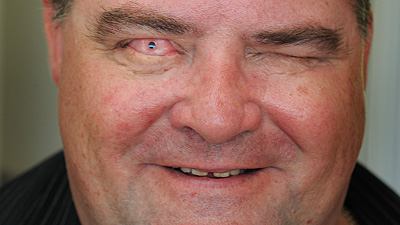



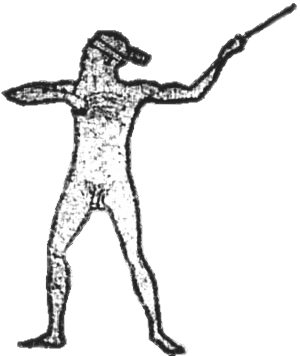

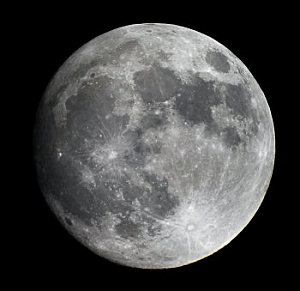 Life is a tenuous thing. Earth is just within Sol’s habitable zone, and constantly pelted with solar radiation and cosmic rays. Rocky scraps of cosmic afterbirth constantly cross Earth’s orbit, threatening to eradicate all terrestrial life. In point of fact, it is almost certain that countless Extinction-Level Events would have sterilized the surface of our plucky planet had it not been for our constant companion and benefactor; a body which unwittingly wards away many of the ills that could befall us: the moon.
Life is a tenuous thing. Earth is just within Sol’s habitable zone, and constantly pelted with solar radiation and cosmic rays. Rocky scraps of cosmic afterbirth constantly cross Earth’s orbit, threatening to eradicate all terrestrial life. In point of fact, it is almost certain that countless Extinction-Level Events would have sterilized the surface of our plucky planet had it not been for our constant companion and benefactor; a body which unwittingly wards away many of the ills that could befall us: the moon. On 17 July 1962, a caravan of scientists, military men, and dignitaries crossed the remote desert of southern Nevada to witness an historic event. Among the crowd were VIPs such as Attorney General Robert F. Kennedy and presidential adviser General Maxwell D. Taylor who had come to observe the “Little Feller I” test shot, the final phase of Operation Sunbeam. The main attraction was a secret device which was bolted to the roof of an armored personnel carrier, a contraption called the The Davy Crockett Weapon System.
On 17 July 1962, a caravan of scientists, military men, and dignitaries crossed the remote desert of southern Nevada to witness an historic event. Among the crowd were VIPs such as Attorney General Robert F. Kennedy and presidential adviser General Maxwell D. Taylor who had come to observe the “Little Feller I” test shot, the final phase of Operation Sunbeam. The main attraction was a secret device which was bolted to the roof of an armored personnel carrier, a contraption called the The Davy Crockett Weapon System. 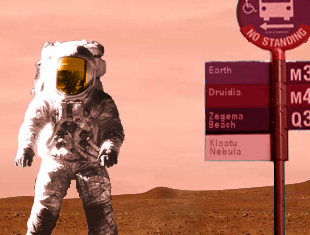 On the 5th of February 1974, NASA’s plucky Mariner 10 space probe zipped past the planet Venus at over 18,000 miles per hour. Mission scientists took advantage of the opportunity to snap some revealing photos of our sister planet, but the primary purpose of the Venus flyby was to accelerate the probe towards the enigmatic Mercury, a body which had yet to be visited by any Earthly device. The event constituted the first ever gravitational slingshot, successfully sending Mariner 10 to grope the surface of Mercury using its array of sensitive instruments. This validation of the gravity-assist technique put the entire solar system within the practical reach of humanity’s probes, and it was used with spectacular success a few years later as Voyagers 1 and 2 toured the outer planets at a brisk 34,000 miles per hour.
On the 5th of February 1974, NASA’s plucky Mariner 10 space probe zipped past the planet Venus at over 18,000 miles per hour. Mission scientists took advantage of the opportunity to snap some revealing photos of our sister planet, but the primary purpose of the Venus flyby was to accelerate the probe towards the enigmatic Mercury, a body which had yet to be visited by any Earthly device. The event constituted the first ever gravitational slingshot, successfully sending Mariner 10 to grope the surface of Mercury using its array of sensitive instruments. This validation of the gravity-assist technique put the entire solar system within the practical reach of humanity’s probes, and it was used with spectacular success a few years later as Voyagers 1 and 2 toured the outer planets at a brisk 34,000 miles per hour. Just after midnight on the morning of June 13, 1942, twenty-one-year-old coastguardsman John Cullen was beginning his foot patrol along the coast of Long Island, New York. Although this particular stretch of beach was considered a likely target for enemy landing parties, the young Seaman was the sole line of defense on that foggy night; and his only weapon, a trusty flashlight, was proving ineffective against the smothering haze. As Cullen approached a dune on the beach, the shape of a man suddenly appeared before him. Momentarily startled, he called out for the shape to identify itself.
Just after midnight on the morning of June 13, 1942, twenty-one-year-old coastguardsman John Cullen was beginning his foot patrol along the coast of Long Island, New York. Although this particular stretch of beach was considered a likely target for enemy landing parties, the young Seaman was the sole line of defense on that foggy night; and his only weapon, a trusty flashlight, was proving ineffective against the smothering haze. As Cullen approached a dune on the beach, the shape of a man suddenly appeared before him. Momentarily startled, he called out for the shape to identify itself. On 21 February 2003, a physician in Hong Kong was feeling particularly unwell. He must have had an inkling that something serious was amiss, for his symptoms closely matched those of a number of patients he had treated in recent weeks: fever, aching muscles, headache, a dry cough, and shortness of breath. An alarmingly high proportion of these people had become critically ill, with inflamed, fluid-saturated lungs. Breathing was rendered somewhat difficult, and death frequently followed.
On 21 February 2003, a physician in Hong Kong was feeling particularly unwell. He must have had an inkling that something serious was amiss, for his symptoms closely matched those of a number of patients he had treated in recent weeks: fever, aching muscles, headache, a dry cough, and shortness of breath. An alarmingly high proportion of these people had become critically ill, with inflamed, fluid-saturated lungs. Breathing was rendered somewhat difficult, and death frequently followed. In the late 1800s, a German high school mathematics instructor named Wilhelm Von Osten was pushing a few scientific envelopes from his home in Berlin. Among other things, he was a student of phrenology, the now discredited theory that one’s intelligence, character, and personality traits can be derived based of the shape of one’s head. But it was his keen interest in animal intelligence that would ultimately win him fame.
In the late 1800s, a German high school mathematics instructor named Wilhelm Von Osten was pushing a few scientific envelopes from his home in Berlin. Among other things, he was a student of phrenology, the now discredited theory that one’s intelligence, character, and personality traits can be derived based of the shape of one’s head. But it was his keen interest in animal intelligence that would ultimately win him fame. 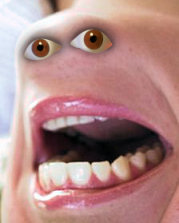 The typical human mouth contains a writhing orgy of bacteria. Most of these microscopic organisms are benign, and some are even beneficial, but one particular variety is a conspicuous troublemaker: Streptococcus mutans. These ubiquitous bacteria thrive on sugars in the mouth, which they consume while excreting lactic acid. This acid is responsible for the great majority of tooth decay in humankind because it erodes the enamel and dentin of the teeth.
The typical human mouth contains a writhing orgy of bacteria. Most of these microscopic organisms are benign, and some are even beneficial, but one particular variety is a conspicuous troublemaker: Streptococcus mutans. These ubiquitous bacteria thrive on sugars in the mouth, which they consume while excreting lactic acid. This acid is responsible for the great majority of tooth decay in humankind because it erodes the enamel and dentin of the teeth. 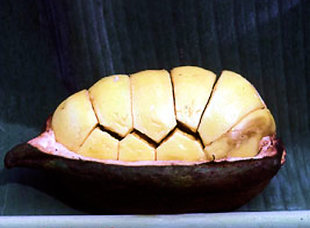
 Just outside Butte, Montana lies a pit of greenish poison a mile and a half wide and over a third of a mile deep. It hasn’t always been so – it was once a thriving copper mine appropriately dubbed “The Richest Hill in the World.” Over a billion tons of copper ore, silver, gold, and other metals were extracted from the rock of southwestern Montana, making the mining town of Butte one of the richest communities in the country, as well as feeding America’s industrial might for nearly a hundred years. By the middle of the twentieth century, the Anaconda Mining Company was in charge of virtually all the mining operations. When running underground mines became too costly in the 1950’s, Anaconda switched to the drastic but effective methods of “mountaintop removal” and open pit mining. Huge amounts of copper were needed to satisfy the growing demand for radios, televisions, telephones, automobiles, computers, and all the other equipment of America’s post-war boom. As more and more rock was excavated, groundwater began to seep into the pit, and pumps had to be installed to keep it from slowly flooding.
Just outside Butte, Montana lies a pit of greenish poison a mile and a half wide and over a third of a mile deep. It hasn’t always been so – it was once a thriving copper mine appropriately dubbed “The Richest Hill in the World.” Over a billion tons of copper ore, silver, gold, and other metals were extracted from the rock of southwestern Montana, making the mining town of Butte one of the richest communities in the country, as well as feeding America’s industrial might for nearly a hundred years. By the middle of the twentieth century, the Anaconda Mining Company was in charge of virtually all the mining operations. When running underground mines became too costly in the 1950’s, Anaconda switched to the drastic but effective methods of “mountaintop removal” and open pit mining. Huge amounts of copper were needed to satisfy the growing demand for radios, televisions, telephones, automobiles, computers, and all the other equipment of America’s post-war boom. As more and more rock was excavated, groundwater began to seep into the pit, and pumps had to be installed to keep it from slowly flooding.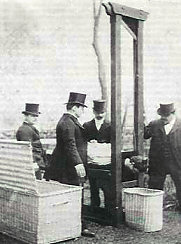 For thousands of years, the forceful removal of the human head has been used as a form of capital punishment. In fact, the word “capital” in the context of punishment was coined to describe execution by decapitation, derived from the Latin word caput, which means “head.” Since the very beginnings of the practice, there has been much speculation and debate regarding the length of time that the head can remain conscious after its removal. Many argue that a beheaded person will almost instantly lose consciousness due to a massive drop in blood pressure in the brain, and/or the heavy impact of the decapitation device. But there are countless eyewitness reports in history describing a few moments of apparent awareness in the victim.
For thousands of years, the forceful removal of the human head has been used as a form of capital punishment. In fact, the word “capital” in the context of punishment was coined to describe execution by decapitation, derived from the Latin word caput, which means “head.” Since the very beginnings of the practice, there has been much speculation and debate regarding the length of time that the head can remain conscious after its removal. Many argue that a beheaded person will almost instantly lose consciousness due to a massive drop in blood pressure in the brain, and/or the heavy impact of the decapitation device. But there are countless eyewitness reports in history describing a few moments of apparent awareness in the victim. In scores of science fiction stories, hapless adventurers find themselves unwittingly introduced to the vacuum of space without proper protection. There is often an alarming cacophony of screams and gasps as the increasingly bloated humans writhe and spasm. Their exposed veins and eyeballs soon bulge in what is clearly a disagreeable manner. The ill-fated adventurers rapidly swell like over-inflated balloons, ultimately bursting in a gruesome spray of blood.
In scores of science fiction stories, hapless adventurers find themselves unwittingly introduced to the vacuum of space without proper protection. There is often an alarming cacophony of screams and gasps as the increasingly bloated humans writhe and spasm. Their exposed veins and eyeballs soon bulge in what is clearly a disagreeable manner. The ill-fated adventurers rapidly swell like over-inflated balloons, ultimately bursting in a gruesome spray of blood. On 16 September 1920, throngs of brokers, clerks, and office workers poured from the buildings lining New York City’s Wall Street as a nearby church bell struck twelve o’clock. The narrow cobblestone street became a river of sputtering automobiles and scurrying pedestrians as the financial district employees set out to make the most of their mid-day break.
On 16 September 1920, throngs of brokers, clerks, and office workers poured from the buildings lining New York City’s Wall Street as a nearby church bell struck twelve o’clock. The narrow cobblestone street became a river of sputtering automobiles and scurrying pedestrians as the financial district employees set out to make the most of their mid-day break.